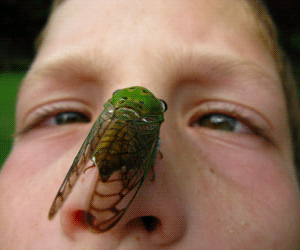The cicadas are coming. Billions of buzzing (relatively harmless) insects will descend upon the eastern United States from Georgia to New England in the coming weeks.
If you’re not familiar with them, cicadas are a unique species. For most of their lives, cicadas live underground as nymphs, digging and feeding on roots. After 17 years underground, in the last few months of their lives, they emerge by the billions, seeking high ground (mostly in trees) on which to shed their exoskeletons and emerge as beautiful winged insects. They mate, the females give birth to new nymphs deep within tree branches, and then they die. While their life cycle is unique, cicadas are most commonly known for their mating song, which is sung by the males and is among the loudest of all insect-produced sounds.
Most people are dreading their arrival. Imagine a fly: Now significantly multiply its size and sound and you’ve got a cicada. Oh, and imagine not one single cicada but billions. Plus, when their life cycle is complete, their carcasses will litter the ground. Are you excited yet? I’m going to ask my wife if she’s excited and will check back with you in a minute. Spoiler alert: She’s not excited.
Until recently I shared her sentiments. That is, until a short film by Samuel Orr about cicadas completely changed my perspective, and taught me a lesson about storytelling in the process.
Second Time Was a Charm
Samuel Orr is a natural-history filmmaker and time-lapse photographer who is creating a one-hour documentary that focuses on the 17-year varieties as well as cicadas in general. He has begun a Kickstarter page to help fund the endeavor, hoping to increase the production quality and be able to film in various countries.
I never thought I’d be interested in this topic. Last week, a friend sent me a link to the video, a seven-minute preview of the documentary, but I was busy at the time and it inevitably slipped my mind. When I received it again from a marketing colleague, I figured it wasn’t a coincidence and gave it a watch. I’m glad I did, and I hope you will as well.
It’s Hard to Hate
I once heard an adage whose attribution is lost to me (if you know where it’s from, please let me know), but it went something like “It’s hard to hate a man if you know his story.” It stuck with me, both because I’m such a fan of storytelling and because it’s so true. Those we love the most are those closest to us, their having been with us our whole lives. Our mothers, fathers, brothers, sisters, wives, husbands and children—we love them unconditionally because they’re entrenched in our lives, as we are in theirs. But it doesn’t require family ties to love or at least care deeply about someone, obviously. On the contrary, it may simply take understanding what’s beyond face value to quell ordinary feelings of anger, frustration and annoyance. David Foster Wallace, in his commencement speech given to Kenyon College’s class of 2005, explained the idea of framing one’s perception. He uses a common source of irritation, traffic and impatient drivers, as an example. (I have edited for brevity.)
The thing is that, of course, there are totally different ways to think about these kinds of situations. It’s not impossible that the Hummer that just cut me off is maybe being driven by a father whose little child is hurt or sick in the seat next to him, and he’s trying to get this kid to the hospital, and he’s in a bigger, more legitimate hurry than I am: It is actually I who am in his way. Or I can choose to force myself to consider the likelihood that everyone else in the supermarket’s checkout line is just as bored and frustrated as I am, and that some of these people probably have harder, more tedious and painful lives than I do.
(You can listen to the full amazing speech here.)
It may make sense to get angry with a person if they cut you off, are rude to you or merely root for a different professional sports team. But when you understand their story, your perspective can completely change.
A week ago I didn’t hate cicadas, though I can’t say I cared for them either. But now that I’ve seen and experienced their story, I’m not capable of perceiving them in the indifferent way I perceived them just a week ago. I know their story. I’ve seen them crawl from below the surface, plod across the earth and climb, excruciatingly slowly, up toward the sun to shed their exoskeletons. I’ve seen them create life, and I’ve seen their lives tragically cut short. I saw the poor nymphs whose wings were deformed or were trapped in their exoskeletons, trying desperately to free themselves. My heart broke as they were snatched up by a passing possum, eaten by ants or flew too low near water and drowned. I smiled as the newborn nymphs dropped from their branches and headed underground for their 17-year slumber.
Your Brand Through Their Lens
Almost everyone is taking your brand at face value. Brand evangelists are nice but are few and far between. How are you helping casual audiences understand your brand’s story? How are you arming your brand’s current fans with conversation-worthy content so they can share it with their friends, who then share it with their friends, and so on? Because as conversations increasingly become the currency of media, it is those stories that others tell about your brand that can determine how an individual feels about your brand and, ultimately, what actions they take.
Samuel Orr told me a story about an insect and completely changed my perspective on it. How are you, or more important how are your brand’s current fans, helping provide new audiences with proper perspective?
Photo Credit: OakleyOriginals via Compfight cc




Pingback: A Pomegranate | A Confession